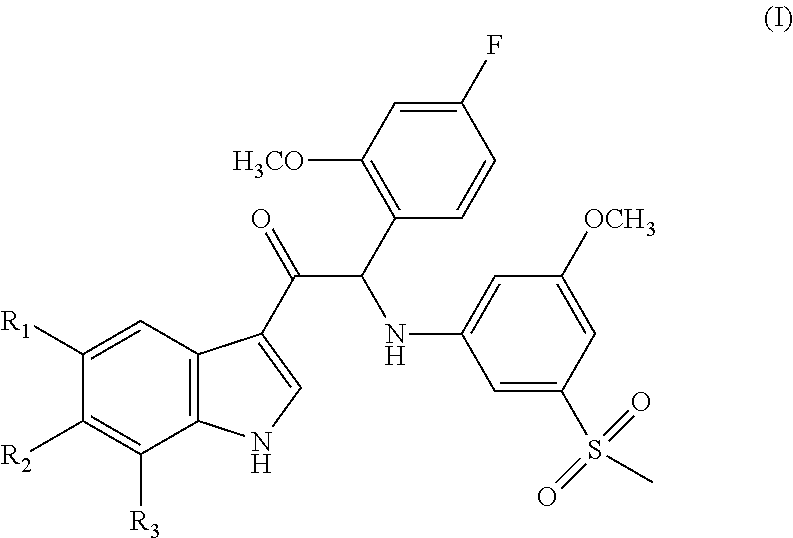Mono- or di-substituted indole derivatives as dengue viral replication inhibitors
a technology of dengue virus and indole derivative, which is applied in the direction of heterocyclic compound active ingredients, biocide, drug compositions, etc., can solve the problems of life-threatening infections in man, dhf has become a leading cause of hospitalization and death among children in endemic regions, and the number of dengue cases is increasing, so as to achieve uniform dosage and facilitate administration.
- Summary
- Abstract
- Description
- Claims
- Application Information
AI Technical Summary
Benefits of technology
Problems solved by technology
Method used
Image
Examples
example 1
synthesis of 1-(6-fluoro-1H-indol-3-yl)-2-(4-fluoro-2-methoxyphenyl)-2-((3-methoxy-5-(methylsulfonyl)phenyl)amino)ethanone (Compound 1) and chiral separation into Enantiomers 1A and 1B
[0072]
Synthesis of Intermediate 1a
[0073]2-(4-Fluoro-2-methoxyphenyl)acetic acid [CAS 886498-61-9] (28.9 g, 157 mmol) was added in small portions to thionyl chloride (150 mL) and the resulting solution was stirred overnight at room temperature. The solvent was concentrated under reduced pressure and co-evaporated with toluene to give 2-(4-fluoro-2-methoxy-phenyl)acetyl chloride 1a (31.8 g) as an oily residue that was used without further purification in the next step.
Synthesis of Intermediate 1b
[0074]A solution of 6-fluoro-1H-indole [CAS 399-51-9] (14.2 g, 105 mmol) in CH2Cl2 (400 mL) was cooled to 0° C. under N2-atmosphere. A solution of diethylaluminum chloride 1M in hexane (160 mL, 160 mmol) was added over a period of 10 min to the stirred solution and the resulting mixture was kept at 0° C. for 40 m...
example 2
synthesis 2-(4-fluoro-2-methoxyphenyl)-1-(6-fluoro-7-methyl-1H-indol-3-yl)-2-((3-methoxy-5-(methylsulfonyl)phenyl)amino)ethanone (Compound 2) and chiral separation into Enantiomers 2A and 2B
[0089]
Synthesis of Intermediate 2a
[0090]A stirred solution of 6-fluoro-7-methyl-1H-indole [CAS 57817-10-4] (5.41 g, 36.2 mmol) in CH2Cl2 (100 mL) was cooled on ice under N2-atmosphere. A solution of diethylaluminum chloride 1M in hexane (54.4 mL, 54.4 mmol) was added dropwise. After 15 min at 0° C., a solution of 2-(4-fluoro-2-methoxyphenyl)-acetyl chloride 1a (11.0 g, 54.4 mmol, for synthesis: see Example 1) in CH2Cl2 (30 mL) was added dropwise while keeping the internal temperature below 5° C. The ice-bath was removed and the resulting suspension was stirred at room temperature for 4 h. The reaction mixture was poured out slowly into a cooled (0° C.) saturated aqueous solution of NaHCO3. The mixture was filtered over Dicalite® and the filter cake was washed with THF. The combined filtrates were...
example 3
Synthesis of 1-(6-chloro-7-methyl-1H-indol-3-yl)-2-(4-fluoro-2-methoxyphenyl)-2-((3-methoxy-5-(methylsulfonyl)phenyl)amino)ethanone (Compound 3) and chiral separation into Enantiomers 3A and 3B
[0104]
Synthesis of Intermediate 3a
[0105]A stirred solution of 6-chloro-7-methyl-1H-indole [CAS 57817-09-1] (3.2 g, 19.3 mmol) in CH2Cl2 (150 mL) under N2-flow, was cooled on an ice-NaCl cooling bath. Diethylaluminum chloride 1M in hexane (29 mL, 29 mmol) was added over a period of 2 min and the cooled solution was stirred at −10° C. for 30 min. A solution of 2-(4-fluoro-2-methoxyphenyl)acetyl chloride 1a (5.48 g, 27.1 mmol, synthesis: see Example 1) in CH2Cl2 (30 mL) was added dropwise over 30 min while keeping the internal temperature below −10° C. and the resulting mixture was stirred for an additional 2 h at −10° C. The reaction was quenched by the slow addition of a solution of potassium sodium tartrate tetrahydrate [CAS 6100-16-9] (10.9 g, 38.6 mmol) in water (10 mL) and the mixture was s...
PUM
 Login to View More
Login to View More Abstract
Description
Claims
Application Information
 Login to View More
Login to View More - R&D
- Intellectual Property
- Life Sciences
- Materials
- Tech Scout
- Unparalleled Data Quality
- Higher Quality Content
- 60% Fewer Hallucinations
Browse by: Latest US Patents, China's latest patents, Technical Efficacy Thesaurus, Application Domain, Technology Topic, Popular Technical Reports.
© 2025 PatSnap. All rights reserved.Legal|Privacy policy|Modern Slavery Act Transparency Statement|Sitemap|About US| Contact US: help@patsnap.com



